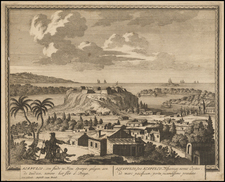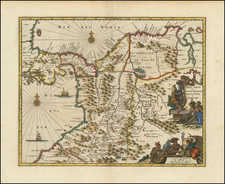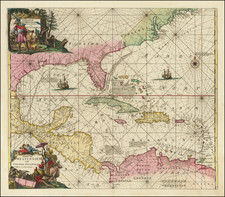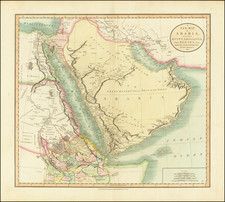Rare separately issued Lafreri School map of the North Atlantic, extending from Texas and the Rocky Mountains in the west to Russia and from Canada to South America.
Fernando Bertelli's very rare separately issued map of the North Atlantic is one of only a very few Lafreri maps which include significant detail in North America. First issued in about 1565, the map is very rare, with only a few examples surviving, generally found in Italian composite atlases bound up to order by Antonio Lafreri of Rome in the 1570s.
The map derives from the rare map of Nicolas de Nicolai. De Nicolai was the French Royal Geographer in the mid-16th Century. De Nicolai's map is one of the first maps to accurately report a number of the earliest contemporary discoveries in the World. De Nicholai's map was essentially an improved version of the crude American map which appeared in the 1548 Valladolid/Seville edition of Medina's Arte de Navegar. De Nicholai's map, substantially enlarged and printed with a copper plate, shows knowledge of Cartier's voyages up the St. Lawrence and many more islands in the Gulf. Along the eastern seaboard, the name C. des maria represents the Outer Banks of the Carolinas, the earliest reference to this region. Tierra Del Licenado Avolloh refers to the unsuccessful attempt at a colony by Spanish Conquistador Lucas Vasquez de Ayllon in South Carolina. The Bahamas are shown, as is Bermuda, and Cuba. The Yucatan is and Island. Flordia is named, as is C. Berton (Breton), Tierra de los Bretons, Jamaica, the Virgin Islands, Hispaniola, Mexico City etc. The Amazon is shown flowing North & South. The mythical Island of Brasil is shown. The following is a link to the map: /gallery/detail/8200 .
Bertelli's map essentially picks up where De Nicholai's map ends. It includes the earliest appearances of the name Canada on a printed map, along with the location of Montreal (Ochelay). Perhaps of greatest note is the addition of two rivers, including one flowing into the Gulf of Mexico, in approximately the correct location for the Mississippi River (although arguably the direction of the river is as or more reminiscent of the Rio Grande). The inclusion of the river is a mystery, as are the settlements located on the River. Hernando De Soto discovered the River in 1541, so it is certainly plausible that Bertelli's map is an early attempt to show the Mississippi River. Bertelli's map differs from similar maps by Camocio and Forlani of the same period in that Bertelli includes more place names. However, the source for many of the names used by Bertelli remains unknown.
Bertelli dedicates his map to his patron, Lord Marco. Other embellishments include a compass rose at center, a scale in the top left corner, and longitude, latitude and rhumb lines. The map demonstrates the fine engraving quality of Italian maps of the mid-16th Century, at a time when Italian maps dominated the market and were without question the finest examples of the mapmaker's art. As Italy was the center of the European map trade during this period, the map exhibits excellent workmanship by its engraver. Indeed, Bertelli was one of the leading publishers and engravers of Venice.
Paolo Forlani (fl. ca. 1560-1571) was a prolific map engraver based in Venice. All that is known of his life are his surviving maps and prints, of which there are almost 100 (185 with later states included in the total). He also produced a globe and two town books. It is likely he came from Verona and that he died in Venice in the mid-1570s, possibly of the plague.










![[Early Photographic Facsimile of the Lopo Homem Planisphere of 1554]](https://storage.googleapis.com/raremaps/img/small/67276.jpg)


![[ Morocco ] Statuum Maroccanorum, Regnorum nempe Fessani, Maroccani, Tafiletanin et Segelomessani Secundum suas Provincias accurate divisorum, Typus generalis novus . . . 1728](https://storage.googleapis.com/raremaps/img/small/95640.jpg)
